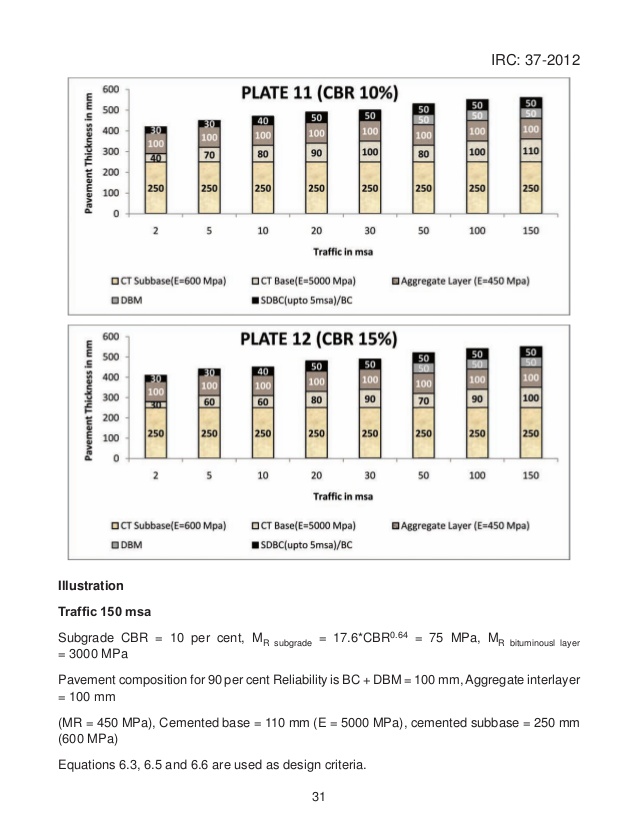
Since there is only one layer of material between the concrete and the sub-grade, this layer can be called as base or sub-base course. Compared to flexible pavement, rigid pavements are placed either directly on the prepared sub-grade or on a single layer of granular or stabilized material. Rigid pavement- Westergaard‟s equations for load and temperature stresses- Examples- Design of slab thickness only as per IRC:58-2002.Rigid pavements have sufficient flexural strength to transmit the wheel load stresses to a wider area below.

There are three subcategories of rigid pavement overlays that are organized depending on the bonding condition at the pavement overlay and existing slab interface. Rigid and flexible overlays are both used for rehabilitation of rigid pavements such as JPCP, JRCP, and CRCP. The required overlay thickness for a structurally sound rigid pavement is much smaller than for one that has reached the end of its service life. Considering an overlay can be constructed on a rigid pavement that has not reached the end of its service life, it is often more economically attractive to apply overlay layers more frequently. Near the end of a rigid pavement's service life, a decision must be made to either fully reconstruct the worn pavement, or construct an overlay layer. Prestressed pavements allow for a thinner slab thickness by partly or wholly neutralizing thermally induced stresses or loadings.

Prestressed concrete pavements have also been used in the construction of highways however, they are not as common as the other three. CRCP‟s solely rely on continuous reinforcing steel to hold the pavement‟s natural transverse cracks together. At transverse joints, dowel bars are typically placed to assist with transferring the load of the vehicle across the cracking. High temperatures and moisture stresses within the pavement creates cracking, which the reinforcing steel holds tightly together.

JRCP‟s are constructed with both contraction joints and reinforcing steel to control the cracking of the pavement. These pavements do not use any reinforcing steel. JPCP‟s are constructed with contraction joints which direct the natural cracking of the pavement. Three main types of concrete pavements commonly used are Jointed plain concrete pavement (JPCP), jointed reinforced concrete pavement (JRCP), and continuously reinforced concrete pavements (CRCP). Joint spacing is determined by the slab panel dimensions. In addition to the slab panels, temperature reinforcements must be designed to control cracking behavior in the slab. The concrete slab is constructed according to a designed choice of plan dimensions for the slab panels, directly influencing the intensity of thermal stresses occurring within the pavement. Rigid pavements are generally constructed in three layers - a prepared subgrade, base or subbase, and a concrete slab. Due to the relatively low tensile strength of concrete, thermal stresses are extremely important to the design considerations of rigid pavements. As pavement design has progressed, many highway engineers have noted that thermally induced stresses in rigid pavements can be just as intense as those imposed by wheel loadings. In addition to design criteria such as traffic loadings, tensile stresses due to thermal energy must also be taken into consideration. Fatigue failure is common among major roads because a typical highway will experience millions of wheel passes throughout its service life. One major design consideration of rigid pavements is reducing fatigue failure due to the repeated stresses of traffic. The typical designed service life of a rigid pavement is between 30 and 40 years, lasting about twice as long as a flexible pavement. Rigid pavements must be designed to endure frequently repeated traffic loadings. The reason for its popularity is due to its availability and the economy. Portland cement concrete (PCC) is the most common material used in the construction of rigid pavement slabs.

Offering high quality riding surfaces for safe vehicular travel, they function as structural layers to distribute vehicular wheel loads in such a manner that the induced stresses transmitted to the subgrade soil are of acceptable magnitudes. Like flexible pavements, rigid highway pavements are designed as all-weather, long-lasting structures to serve modern day high-speed traffic. In addition, they commonly serve as heavy-duty industrial floor slabs, port and harbor yard pavements, and heavy-vehicle park or terminal pavements. Rigid pavements are generally used in constructing airports and major highways, such as those in the interstate highway system.


 0 kommentar(er)
0 kommentar(er)
